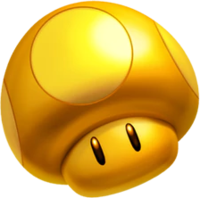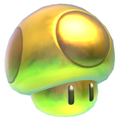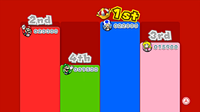Calamitous calamari! We've landed in a pond of quicksand!
This is where I'll put random stuff I'm working on, as people do with sandboxes here.
Golden Mushroom merge concept
- This page is about the item debuting in Mario Party 2. For other gold-colored mushrooms, see Golden Mushroom.
| Golden Mushroom | |
|---|---|
 Artwork of the Golden Mushroom for Super Nintendo World | |
| First appearance | Mario Party 2 (1999) |
| Latest appearance | Super Nintendo World "Power-Up Band Key Challenges" (2021) |
| Effect | Restores all HP and BP. |
Golden Mushrooms, also known as Gold Mushrooms, are a type of Mushroom, either considered rare or uncommon across appearances. They resemble a crownless, dark-stalked version of the Golden Dash Mushroom from the Mario Kart series, or in games such as New Super Mario Bros. 2, a lighter toned golden mushroom with dark spots.
Mario Party 2
In Mario Party 2, Golden Mushrooms appear in the minigames Grab Bag and Rakin' 'em In, where they are worth three Mushrooms. Other Golden Mushrooms appear as a usable item, though these are actually a nonstandard yellow design of Super Mushroom.
Mario & Luigi: Superstar Saga / Mario & Luigi: Superstar Saga + Bowser's Minions
In Mario & Luigi: Superstar Saga and its remake, it fully restores both Heart Points and Bros. Points for a single brother. There are only five Golden Mushrooms in-game, though it can also be stolen using Swing Bros. from Fawful and Popple (in the original game). In the remake, bosses like Iggy, Morton, Wendy, and Larry always drop a Golden Mushroom when defeated. Ten Golden Mushrooms can be obtained from the Information Booth after 800 attacks are dodged. They also have a chance to be dropped by Clumphs and Boos.
In Mario & Luigi: Bowser's Inside Story and its remake, the Star Candy replaces the Golden Mushroom, with the Cheesy Drumstick being the Bowser equivalent in the remake. In Mario & Luigi: Dream Team and Mario & Luigi: Paper Jam, they are replaced by various Candies.
New Super Mario Bros. 2
Gold Mushrooms appear in New Super Mario Bros. 2 in the Coin Rush mode, where they replace 1-Up Mushrooms. The mushrooms resemble previous iterations, except with dark instead of light spots. Collecting one gives Mario 50 coins (or 100 coins if he is Gold Mario).
Captain Toad: Treasure Tracker
Gold Mushrooms appear as rare collectibles in some courses in Captain Toad: Treasure Tracker and its Nintendo Switch and Nintendo 3DS ports, appearing and acting as they do in New Super Mario Bros. 2. Collecting these mushrooms is usually a secondary objective in the courses they appear in. Some Gold Mushrooms can only be found through invisible Pluck Patches, which can be seen once Captain Toad approaches them or reveals them with his headlamp.
Puzzle & Dragons: Super Mario Bros. Edition
Gold Mushrooms are rare items in Puzzle & Dragons: Super Mario Bros. Edition. They retain their appearance from New Super Mario Bros. 2, and are obtained from ? Blocks or dropped after defeating some enemies with a 10+ combo, such as 2-Goomba Towers and Paragoombas. There is an even rarer variation called Grand Gold Mushroom. It raises the Skill levels of all Toad colors, and all types/forms of Goombas and Piranha Plants from Level 1-4.
Mario Tennis Aces
In Mario Tennis Aces, Gold Mushrooms sometimes appear in Boo Hunt mode, floating over the court. They can be hit with a ball for coins. They retain their appearance from New Super Mario Bros. 2.
Super Nintendo World
A Golden Mushroom is a key item in the "Power-Up Band Key Challenges" attraction at Super Nintendo World, where it is stolen by Bowser Jr. and attendees help Peach recover it by collecting three keys and defeating Bowser Jr. in an interactive boss battle.[1]
Profiles
New Super Mario Bros. 2
- North American website bio: "This valuable fungus only appears in Coin Rush mode. But if you manage to find one, you'll get 50 coins on the spot."
Gallery
Names in other languages
| Language | Name | Meaning |
|---|---|---|
| Japanese | きんいろキノコ Kin'iro Kinoko ゴールデンキノコ[2] Gōruden Kinoko ゴールドキノコ[3] Gōrudo Kinoko |
Golden Mushroom; former is from Mario Party 2, latter is from Mario & Luigi RPG and Super Nintendo World Gold Mushroom (New Super Mario Bros. 2, Captain Toad: Treasure Tracker, etc.) |
| Chinese (simplified) | 金蘑菇 Jīn Mógu 金色蘑菇[4] Jīnsè Mógu |
Gold Mushroom (Mario & Luigi: Superstar Saga) Golden Mushroom (Super Nintendo World) |
| Chinese (traditional) | 金色蘑菇[5] Jīnsè Mógu |
Golden Mushroom |
| French | Champignon d'or |
Gold Mushroom |
| German | Goldpilz[citation needed] |
Gold Mushroom |
| Spanish | Champiñón dorado |
Golden Mushroom |
Point rewrite concept
(Not doing anything with it yet, but that's because I need to sleep)
Points are units of score in games of the Super Mario franchise. They are acquired by defeating enemies or bosses, collecting coins, etc. The total of all received points is usually called the score. The first game of the Super Mario franchise to include points was the original Donkey Kong arcade game, where they determine the player's ranking.
Description
In Super Mario Bros., Mario can earn points by interacting with the environment in various ways; for instance, he earns 50 points for breaking Bricks, 200 for collecting a coin, and 1,000 for collecting a power-up. Points can also be earned upon defeating an enemy, with higher points earned for sequences of defeated enemies without landing back on the ground. There are different sequences for different methods of defeating enemies:
- Stomping on multiple Goombas, Koopa Troopas, and Buzzy Beetles grants the following sequence of points: 100, 200, 400, 500, 800, 1,000, 2,000, 4,000, 5,000, 8,000, and then all 1-Ups.
- Enemies defeated by a Koopa Shell or Buzzy Shell grant the following sequence of points: 500, 800, 1,000, 2,000, 4,000, 5,000, 8,000, and then all 1-Ups.
- Kicking a shell itself usually grants 400 points, though it may grant 500 or 800 points if done after the player stomps on the enemy.
- Stomping two Goombas with one jump grants Mario 100 + 400 points (200 + 500 if it occurs just after he stomps on another Goomba).
- Defeating most enemies with fireballs grants 200 points, though defeating a Goomba grants 100 points, defeating a Hammer Bro grants 1,000 points, and defeating Bowser with fireballs grants 5,000 points.
Less common enemies may earn more points, even when not in sequence. Stomping on a Lakitu grants 800 points, and stomping on a Hammer Bro grants 1,000 points.
At the end of each stage, pulling down the flag on the flagpole grants 100, 400, 800, 2,000, or 5,000 points depending on how high the flagpole is touched. At the end of a level, there is a bonus that grants 50 points for each remaining second on the timer, though no such bonus is present in castle levels in the original NES version; it is, however, in Super Mario All-Stars and the Challenge mode of Super Mario Bros. Deluxe.
Later games use a point chain of 200, 400, 800, 1,000, 2,000, 4,000, 8,000, and then all 1-Ups (it is preceded by 100 in Super Mario Bros. 3). This chain typically applies to stomping on multiple consecutive enemies, kicking a shell at enemies, running into enemies while invincible (starting with Super Mario World), and while sliding down slopes (as of New Super Mario Bros.); in Super Mario 3D World, the chain loops back to the start while invincible.
A chain started with Lakitu or any member of the Hammer Bro family starts at 1,000 since New Super Mario Bros., as do enemies defeated by touching goals. However, certain items can affect these chains, as stomping enemies while using a P-Wing in Super Mario Bros. 3, shell-dashing into foes in New Super Mario Bros., or running into foes in the White Raccoon form or White Tanooki form in New Super Mario Bros. 2 and Super Mario 3D World, respectively, grants only the initial point value for each enemy beaten. In Super Mario Bros. Wonder, due to a lack of points, the chain displays differently: Good, Great, Super, Fantastic, Excellent, Incredible, Wonderful, and then all 1-Ups.
History
In many games, points are largely aesthetic and serve only as a secondary goal, such as in Super Mario World and the New Super Mario Bros. games; in others, such as Super Mario 3D Land, they may be replaced entirely by another mechanic, such as coins. However, there are a few times where points hold a purpose for the gameplay.
Super Mario series
Super Mario Land
In Super Mario Land, points let Mario continue after a Game Over for earning 100,000 points.
Super Mario Bros. 3 / Super Mario Advance 4: Super Mario Bros. 3
In Super Mario Bros. 3, points spawn an N-Mark Spade Panel for every 80,000 points earned. Its Game Boy Advance remake, Super Mario Advance 4: Super Mario Bros. 3, features two e-Reader cards that made changes to how points were earned: a Japan-only card that doubled any points gained, and an unreleased card that made the point chain start at 4,000 instead of 100.[6]
Super Mario Advance
Super Mario Advance adds a score system based on the other 2D Super Mario games to its version of Super Mario Bros. 2; this includes the combo racked up for kicking shells into foes or running into enemies while invincible.
Super Mario World: Super Mario Advance 2
Super Mario World: Super Mario Advance 2, in addition to the original game's score system, tracks the best scores for the Special Zone's courses once they are all cleared.
Super Mario 3D World / Super Mario 3D World + Bowser's Fury
In Super Mario 3D World, points reappear, though they serve a purpose only in multiplayer mode: The game keeps track of the points each player gains (though any points earned while riding Plessie are awarded to all players) and displays the totals at the end of each level, with the player with the most points getting a crown as a prize. This crown is worth 5,000 points if an active player wears it to the end of the next level, but it can be lost if the player who holds it gets hit by an enemy, and it can be stolen if another player ground-pounds the crowned character. If the crowned player grabs a Double Cherry, only one instance of their character wears the crown. Unlike most other games, Super Mario 3D World simply tracks the highest score for each level, rather than having a running total throughout the game.
This system remains the same in the Nintendo Switch port, although points are not present in the Bowser's Fury side mode and are instead replaced by coins.
Super Paper Mario
In Super Paper Mario, points are used to level up the characters, replacing Star Points from Paper Mario and Paper Mario: The Thousand-Year Door. Super Paper Mario features Speed Flowers and Slow Flowers, which speed up or slow down gameplay, respectively, and also triple any points gained while the items are in effect. The game also subtracts points instead of giving extra lives when the point chain gets far enough; this is because the game has no extra life system.
Mario Kart series
In the Mario Kart series, the Grand Prix and Versus modes award points based on the player's finishing position. At the end of the course/tournament, the player with the most points gets a gold trophy, and the second- and third-place finishers receive silver and bronze trophies, respectively. Points are also used in Battle Mode, with different uses throughout the games.
In Mario Kart: Double Dash!! and Mario Kart DS, the player can set a rule that makes the winner gain a point, and (in Mario Kart DS only) win the match when reaching a predetermined number of points. In Mario Kart Wii, the player earns a point for every balloon popped or coin collected. At the end, the teams' points are totaled and the team with more wins the match. Winning a predetermined number of matches means winning the battle.
In Mario Kart 7 and Mario Kart 8, points work as in Mario Kart Wii but are summed individually. In Balloon Battle, players can earn an unlimited number of points, but in Mario Kart 7's game Coin Runners, a player can earn only 10 points per battle due to the game's limit of 10 coins carried at a time.
Super Mario sports games
Various Super Mario sports titles use the same point system as in the real sport depicted, such as shooting a basketball into the net in Mario Hoops 3-on-3 and Mario Sports Mix, scoring goals in the Mario Strikers series, and trying to get the lowest score in the Mario Golf series.
References
- ^ Official Super Nintendo World at Universal Studios Japan webpage
- ^ Super Nintendo World Japanese website
- ^ https://www.nintendo.co.jp/3ds/abej/coinrush/index.html
- ^ Official simplified Chinese website for Super Nintendo World. Retrieved Jaunary 9, 2021.
- ^ https://www.nintendo.com.hk/nsmb2/coinrush/index.html
- ^ TCRF. Super Mario Advance 4: Super Mario Bros. 3 § 4000 Points Switch. The Cutting Room Floor. Retrieved August 17, 2016.
| General video game terms | |
|---|---|
| Cheat code • Completion • Continue • Easter egg • Extra life • Fourth wall • Game Over • Glitch • Missable content • Point • Unrevisitable area • Unwinnable state | |








